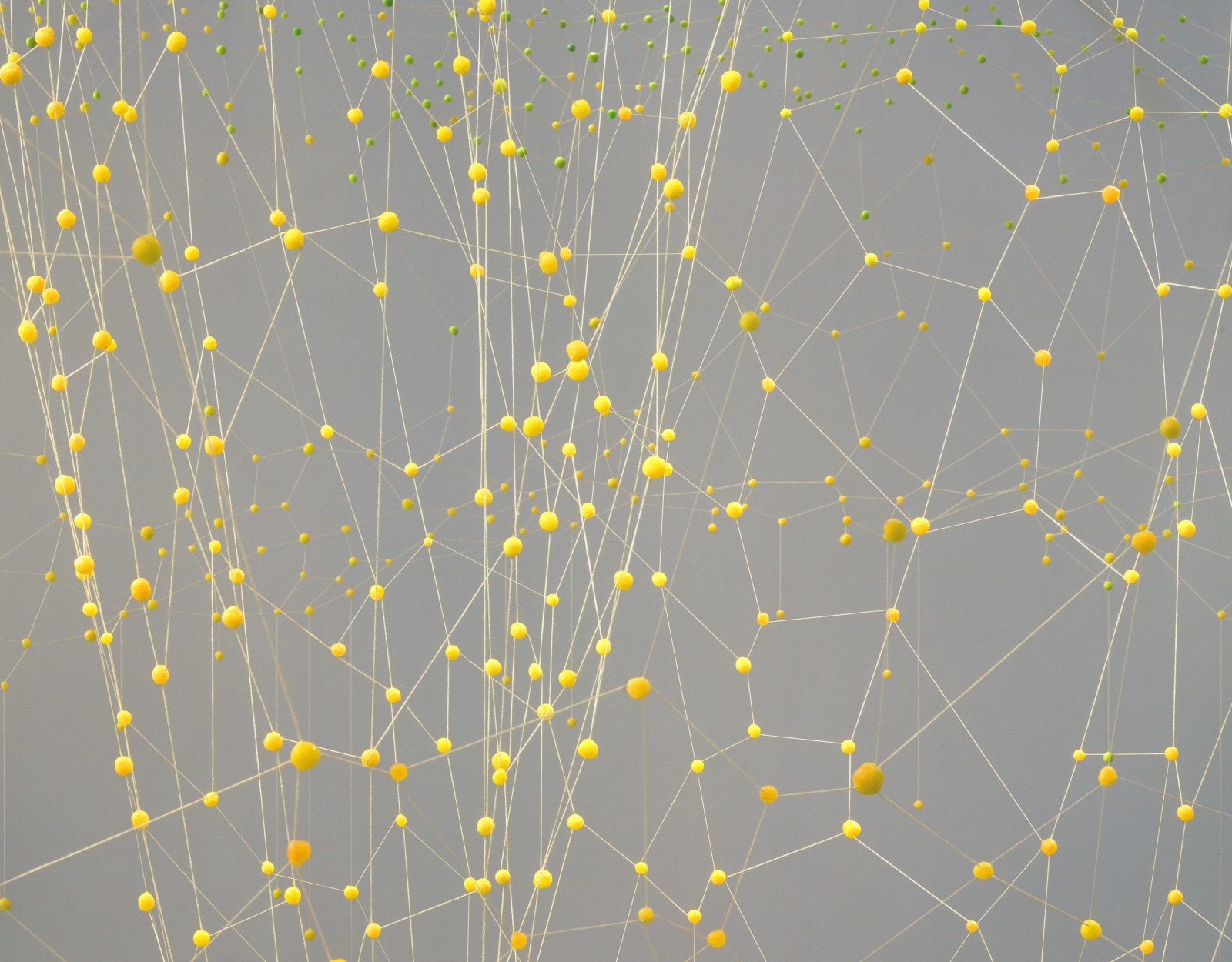
Drawing and speaking are very close. To speak is a form of spatial demarcation, linguistically establishing the relationship between a concept and its sound pattern (to use the Saussurean term). The drawn line has a similarly essential function, simple and elemental. In the 1960s and ‘70s artists such as Richard Tuttle and Eva Hesse, examples of whose work served as the axis for this show, released drawing from its referents and its two‐dimensional grounding on paper or canvas. Set loose, drawing suddenly determined rather than reflected its subject. In curator Catherine de Zegher’s elegant group show, you could all but hear what happened: drawing found its voice.
‘Freeing the Line’ brought together old and new works by both familiar artists and others less well known. Its discreet, understated tone was set by an untitled 1972 wall piece by Tuttle in which two sets of parallel steel wires, strung between nails in the wall, flanked a middle pair to keep all three in a state of harmonious disconnect. An untitled piece from 1974 by the relatively unknown Venezuelan artist Gego (Gertrud Goldschmidt), a dangling cylinder composed of steel wire triangles bound by metal clasps, extended Tuttle’s idea to a tenuous and geometrically complex end. Paradoxically, the rigidity of the wire exposed the inherent fragility of the cylinder, each triangle seemingly on the verge of collapse. This was even more true of Gego’s Drawing without Paper 86/7 (1986), a wall piece consisting of two squares, one larger than the other, in whose disjointed elements – an antenna and other metal wires and rods – she revealed the latent possibilities in the junk that surrounds us. Julie Mehretu’s Old Gods (2006) was a scrim‐like composition built up from seemingly generic infrastructure blueprints, with lines erased, overlaid and re‐inscribed to a point at which they separated from any discernible functionality. A comparable sense of systems being more interesting when they’ve gone awry animated Czech artist Karel Malich’s suggested that even during the heyday of Calder mobiles there were other more rigorous and fanciful ways of flinging lines into space.
In Rajani Shettar’s Vasanta (Spring/Transition) (2005), the sole occupant of one small viewing room, sprightly vernal-coloured pellets clung to a massive web of cotton thread. The somewhat distended suspension – the upper sections perceptibly strained with the weight, the lower levels drooping as though wet – spared the piece from being too pretty. Hung in a loose vortex, the beaded web was hypnotic, like an enticing slow‐motion whirlpool.
Jöelle Tuerlinckx’s Room of Volume of Air – 13 Elements (1993–2004), arguably the show’s fulcrum, exerted an even more delicate power. Tuerlinckx fashions oblong and square armatures from lengths of wire, metal rod or wood. Laid across their tops, or balanced at the ends of the structured volumes of air, were found objects such as sticks, paper, ribbon and, in one element titled The Little Van Eyck, a suitably paint‐spackled brush, along with pink and red streamers. Surveying the room had something of the feeling of looking at skeletal ruins, though the pieces were completely intact. The only connection between the structures and their ornamentation was the placement Tuerlinckx had chosen. It gave the work a spirit of contingent, intuitive insouciance, based as much on a random coming together of parts as on a linear precision. These wispy boxfuls of air had the almost‐gone quality of a spindly Giacometti. The bits of ribbon or coloured paper resembled sad bits of left‐over triumphal decorations, memorials to nothing.
Anchoring the last room were several Hesse pieces, including an untitled wall piece from 1966, a moon‐surfaced black‐on‐black circle within a wooden square, with a long tail of black rubber tubing protruding through its middle. The visually guttural effect was a natural lead‐in to the unmistakable scream of Monika Grzymala’s Transition (2006), more than eight kilometres of merged black and white masking tape howling over the walls across a window and around a large pillar as if applied at gale force. Looking like a storm of unspooled celluloid and magnetic tape, Grzymala’s furious, cacophonic jumble deserved a space all to itself, although it brought the show to an exclamatory finish. Throughout, De Zegher maintained an anticipatory tension whose effect was almost narrative, even suspenseful. Suspense, as Saul Bellow pointed out in Cousins (1984), is ‘the principal characteristic of our existence […] Nobody – nobody at all – can say how it’s going to turn out.’ The result of De Zegher’s subtle curatorial decisions was to make the admittedly abstract idea of suspense gracefully and forcefully palpable by building up from a whisper to a scream.
-Megan Ratner